My code uses a geometry shader to produce thick lines using this: https://forum.libcinder.org/topic/smooth-thick-lines-using-geometry-shader
(Uses geometry shader approach)
I get it work on my local machine using an Intel HD Graphics card. However, if I use the same settings on my destination machine the lines that are drawn with weird gaps.
I don't understand why, because on different Intel HD it works. Note that my target is a NVS 300 that is fairly old, but supports FL10_1 and Geometry shader I guess. The Intel devices I try it with might be a bit newer.
Since I force the feature level on my development on device creation to be 10_1 I expect no difference.
I don't see any error codes that could hint a arbitrary behavior in the output that would explain it, even if I set up native code debugging or remote debugging.
Does anyone have a clue why this behaves differently?
I could add images, but you basically see a thick sine curve on my local machine and a thick ,but fractioned with gaps, on the target.
Thanks in advance for any clues.
cbuffer constBuffer
{
float THICKNESS;
float2 WIN_SCALE;
};
struct PSInput
{
float4 Position : SV_POSITION;
};
float2 toScreenSpace(float4 vertex)
{
//float2 WIN_SCALE = { 100.0f, 100.0f };
return float2(vertex.xy) * WIN_SCALE;
}
[maxvertexcount(7)]
void main(lineadj float4 vertices[4] : SV_POSITION, inout TriangleStream<PSInput> triStream)
{
//float2 WIN_SCALE = { 100.0f, 100.0f };
float2 p0 = toScreenSpace(vertices[0]); // start of previous segment
float2 p1 = toScreenSpace(vertices[1]); // end of previous segment, start of current segment
float2 p2 = toScreenSpace(vertices[2]); // end of current segment, start of next segment
float2 p3 = toScreenSpace(vertices[3]); // end of next segment
// perform naive culling
float2 area = WIN_SCALE * 1.2;
if (p1.x < -area.x || p1.x > area.x)
return;
if (p1.y < -area.y || p1.y > area.y)
return;
if (p2.x < -area.x || p2.x > area.x)
return;
if (p2.y < -area.y || p2.y > area.y)
return;
float2 v0 = normalize(p1 - p0);
float2 v1 = normalize(p2 - p1);
float2 v2 = normalize(p3 - p2);
// determine the normal of each of the 3 segments (previous, current, next)
float2 n0 = { -v0.y, v0.x};
float2 n1 = { -v1.y, v1.x};
float2 n2 = { -v2.y, v2.x};
// determine miter lines by averaging the normals of the 2 segments
float2 miter_a = normalize(n0 + n1); // miter at start of current segment
float2 miter_b = normalize(n1 + n2); // miter at end of current segment
// determine the length of the miter by projecting it onto normal and then inverse it
//float THICKNESS = 10;
float length_a = THICKNESS / dot(miter_a, n1);
float length_b = THICKNESS / dot(miter_b, n1);
float MITER_LIMIT = -1;
//float MITER_LIMIT = -1;
//float MITER_LIMIT = 1;
PSInput v;
float2 temp;
//// prevent excessively long miters at sharp corners
if (dot(v0, v1) < -MITER_LIMIT)
{
miter_a = n1;
length_a = THICKNESS;
// close the gap
if (dot(v0, n1) > 0)
{
temp = (p1 + THICKNESS * n0) / WIN_SCALE;
v.Position = float4(temp, 0, 1.0);
triStream.Append(v);
temp = (p1 + THICKNESS * n1) / WIN_SCALE;
v.Position = float4(temp, 0, 1.0);
triStream.Append(v);
v.Position = float4(p1 / WIN_SCALE, 0, 1.0);
triStream.Append(v);
triStream.RestartStrip();
}
else
{
temp = (p1 - THICKNESS * n1) / WIN_SCALE;
v.Position = float4(temp, 0, 1.0);
triStream.Append(v);
temp = (p1 - THICKNESS * n0) / WIN_SCALE;
v.Position = float4(temp, 0, 1.0);
triStream.Append(v);
v.Position = float4(p1 / WIN_SCALE, 0, 1.0);
triStream.Append(v);
triStream.RestartStrip();
}
}
if (dot(v1, v2) < -MITER_LIMIT)
{
miter_b = n1;
length_b = THICKNESS;
}
// generate the triangle strip
temp = (p1 + length_a * miter_a) / WIN_SCALE;
v.Position = float4(temp, 0, 1.0);
triStream.Append(v);
temp = (p1 - length_a * miter_a) / WIN_SCALE;
v.Position = float4(temp, 0, 1.0);
triStream.Append(v);
temp = (p2 + length_b * miter_b) / WIN_SCALE;
v.Position = float4(temp, 0, 1.0);
triStream.Append(v);
temp = (p2 - length_b * miter_b) / WIN_SCALE;
v.Position = float4(temp, 0, 1.0);
triStream.Append(v);
triStream.RestartStrip();
}

